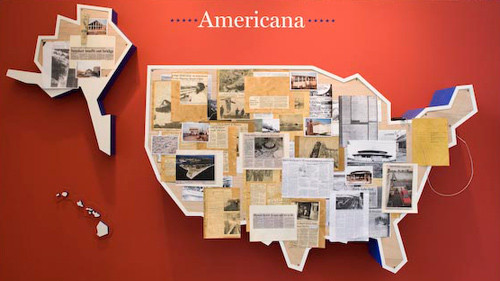Americana: Connecticut
12 Feb - 01 Mar 2008
AMERICANA: CONNECTICUT
Pleasure Beach Plans Considered
Mary Augustine Gallery
Feb. 12–Mar. 1, 2008
The American amusement park is a place that promises magic, the realization of fantasy and escape. Built as confined spaces for release, where a good time is guaranteed, today their presence declines annually. America's interest in leisure has shifted from these outdoor utopias to more virtual and technologically advanced destination points. With this shift, we witness a proliferation of unused plots of land; land that sits waiting to be sold or developed. Sometimes all that remains is the standing skeleton of a once thriving site. This is the case of Pleasure Beach located in Bridgeport, Connecticut.
Pleasure Beach Plans Considered introduces this site as one of the many parks that provided amusement for Connecticut's working class from the end of the nineteenth century to the beginning of the twentieth. Pleasure Beach, also known as Steeple Chase Island, opened in 1892 as a privately owned state park, then reopened in 1905 after George Tilyou purchased the site and renamed it Steeple Chase Island after Steeplechase Park, his Brooklyn success story. The site was renamed Pleasure Beach in 1938 and stayed open until 1951, which was to be the last year that the amusement park's rides were fully active. After 1996 when the bridge, the only point of entry to this 65 acre peninsula, burned beyond repair, the former amusement park completely closed to the public. Pleasure Beach, which, like Cape Cod was also a summer holiday getaway for many Connecticut residents became the ghost town that it is today, when many of these vacationers lost their possessions in the fire.
This exhibition chronicles the life of Pleasure Beach through photographs and newspaper articles from its opening day to the present. These artifacts are added on the boarded vitrine almost daily, as a means of accounting the site's tumultuous transitions over the course of the last two centuries. Pleasure Beach Plans Considered will culminate in a stacking of posted artifacts of and about Pleasure Beach today.
The life of this site illustrates the melancholic cyclical nature of progress and modernization. The documents presented aim to investigate the site through the many decades since it first opened in 1892, and reveal the successful and tumultuous stories that keep Pleasure Beach enchanting.
I would like to thank Erik Hedeås for his help with constructing the vitrine's wood inserts and Mary K. Witkowski, Sarah Greenberg, and Benjamin Ortiz at the Bridgeport Public Library for their help in providing the source material for this exhibition.
Petrushka Bazin
Pleasure Beach Plans Considered
Mary Augustine Gallery
Feb. 12–Mar. 1, 2008
The American amusement park is a place that promises magic, the realization of fantasy and escape. Built as confined spaces for release, where a good time is guaranteed, today their presence declines annually. America's interest in leisure has shifted from these outdoor utopias to more virtual and technologically advanced destination points. With this shift, we witness a proliferation of unused plots of land; land that sits waiting to be sold or developed. Sometimes all that remains is the standing skeleton of a once thriving site. This is the case of Pleasure Beach located in Bridgeport, Connecticut.
Pleasure Beach Plans Considered introduces this site as one of the many parks that provided amusement for Connecticut's working class from the end of the nineteenth century to the beginning of the twentieth. Pleasure Beach, also known as Steeple Chase Island, opened in 1892 as a privately owned state park, then reopened in 1905 after George Tilyou purchased the site and renamed it Steeple Chase Island after Steeplechase Park, his Brooklyn success story. The site was renamed Pleasure Beach in 1938 and stayed open until 1951, which was to be the last year that the amusement park's rides were fully active. After 1996 when the bridge, the only point of entry to this 65 acre peninsula, burned beyond repair, the former amusement park completely closed to the public. Pleasure Beach, which, like Cape Cod was also a summer holiday getaway for many Connecticut residents became the ghost town that it is today, when many of these vacationers lost their possessions in the fire.
This exhibition chronicles the life of Pleasure Beach through photographs and newspaper articles from its opening day to the present. These artifacts are added on the boarded vitrine almost daily, as a means of accounting the site's tumultuous transitions over the course of the last two centuries. Pleasure Beach Plans Considered will culminate in a stacking of posted artifacts of and about Pleasure Beach today.
The life of this site illustrates the melancholic cyclical nature of progress and modernization. The documents presented aim to investigate the site through the many decades since it first opened in 1892, and reveal the successful and tumultuous stories that keep Pleasure Beach enchanting.
I would like to thank Erik Hedeås for his help with constructing the vitrine's wood inserts and Mary K. Witkowski, Sarah Greenberg, and Benjamin Ortiz at the Bridgeport Public Library for their help in providing the source material for this exhibition.
Petrushka Bazin

